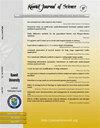Phytochemical analysis and molecular mechanisms of anticancer activity of Stevia rebaudiana extract in gastric cancer cells: In silico docking and functional assays on apoptosis and cell migration
IF 1.1
4区 综合性期刊
Q3 MULTIDISCIPLINARY SCIENCES
引用次数: 0
Abstract
Gastric carcinoma (GC) continues to be a substantial worldwide health problem, requiring the investigation of new treatment approaches. Early GC, which can be multifocal and portend a worse prognosis, is classified into four types: Type-I (protruding), Type-II (superficial), Type-III (excavating), and Type-IV (infiltrating with lateral spreading). This research aimed to explore the possible anti-cancer properties of Stevia rebaudiana ethanol extract (EESR) on SGC-7901 GC cells. We conducted a thorough evaluation of the cytotoxic, anti-proliferative, anti-migratory, and pro-apoptotic effects of EESR, as well as its capacity to regulate the PI3K/AKT/mTOR signaling pathway. We used a range of assays, including 3-[4,5-dimethylthiazol-2-yl]-2,5-diphenyl-tetrazolium-bromide (MTT), clonogenic, Transwell chambers, Annexin-V, Western blotting, and molecular docking analysis, to investigate and understand the molecular pathways responsible for the bioactivity of EESR. The findings of our study showed that the viability of cells, capacity to form colonies, ability to migrate, and ability to invade were reduced in a manner that depended on the concentration of EESR. This decrease was accompanied by the initiation of apoptosis and the suppression of the PI3K/AKT/mTOR signaling pathway. The results showed statistically significant findings, with a substantial decrease (∗∗p < 0.01) in colony formation and migration, as well as an increase in apoptotic cells (∗∗p < 0.01) after EESR treatment. Additional molecular docking studies demonstrated substantial interactions between Stevioside, a crucial component of EESR, and the PI3K-mTOR protein complex. These noteworthy results demonstrate the potential of EESR as a natural therapeutic agent for GC. Further study is needed to determine its effectiveness for clinical use.

甜菊叶提取物在胃癌细胞中的植物化学分析及抗癌作用的分子机制:细胞凋亡和细胞迁移的硅对接和功能研究
胃癌(GC)仍然是一个重大的全球健康问题,需要研究新的治疗方法。早期胃癌可为多灶性,预后较差,可分为1型(突出型)、2型(浅表性)、3型(挖掘型)和4型(浸润伴外侧扩散)。本研究旨在探讨甜菊糖乙醇提取物(EESR)对SGC-7901细胞的抗癌作用。我们全面评估了EESR的细胞毒性、抗增殖、抗迁移和促凋亡作用,以及其调节PI3K/AKT/mTOR信号通路的能力。我们使用了一系列的检测方法,包括3-[4,5-二甲基噻唑-2-基]-2,5-二苯基溴化四唑(MTT)、克隆性、Transwell室、Annexin-V、Western blotting和分子对接分析,来研究和了解EESR生物活性的分子途径。我们的研究结果表明,细胞的活力、形成菌落的能力、迁移能力和入侵能力都随着EESR的浓度而降低。这种减少伴随着细胞凋亡的启动和PI3K/AKT/mTOR信号通路的抑制。结果显示了统计学上显著的发现,显著降低(∗∗p <;0.01)在集落形成和迁移,以及凋亡细胞的增加(∗∗p <;EESR治疗后0.01)。另外的分子对接研究表明,甜菊糖甙(EESR的关键成分)与PI3K-mTOR蛋白复合物之间存在大量相互作用。这些值得注意的结果显示了EESR作为GC天然治疗剂的潜力。临床应用的有效性有待进一步研究。
本文章由计算机程序翻译,如有差异,请以英文原文为准。
求助全文
约1分钟内获得全文
求助全文
来源期刊

Kuwait Journal of Science
MULTIDISCIPLINARY SCIENCES-
CiteScore
1.60
自引率
28.60%
发文量
132
期刊介绍:
Kuwait Journal of Science (KJS) is indexed and abstracted by major publishing houses such as Chemical Abstract, Science Citation Index, Current contents, Mathematics Abstract, Micribiological Abstracts etc. KJS publishes peer-review articles in various fields of Science including Mathematics, Computer Science, Physics, Statistics, Biology, Chemistry and Earth & Environmental Sciences. In addition, it also aims to bring the results of scientific research carried out under a variety of intellectual traditions and organizations to the attention of specialized scholarly readership. As such, the publisher expects the submission of original manuscripts which contain analysis and solutions about important theoretical, empirical and normative issues.
 求助内容:
求助内容: 应助结果提醒方式:
应助结果提醒方式:


